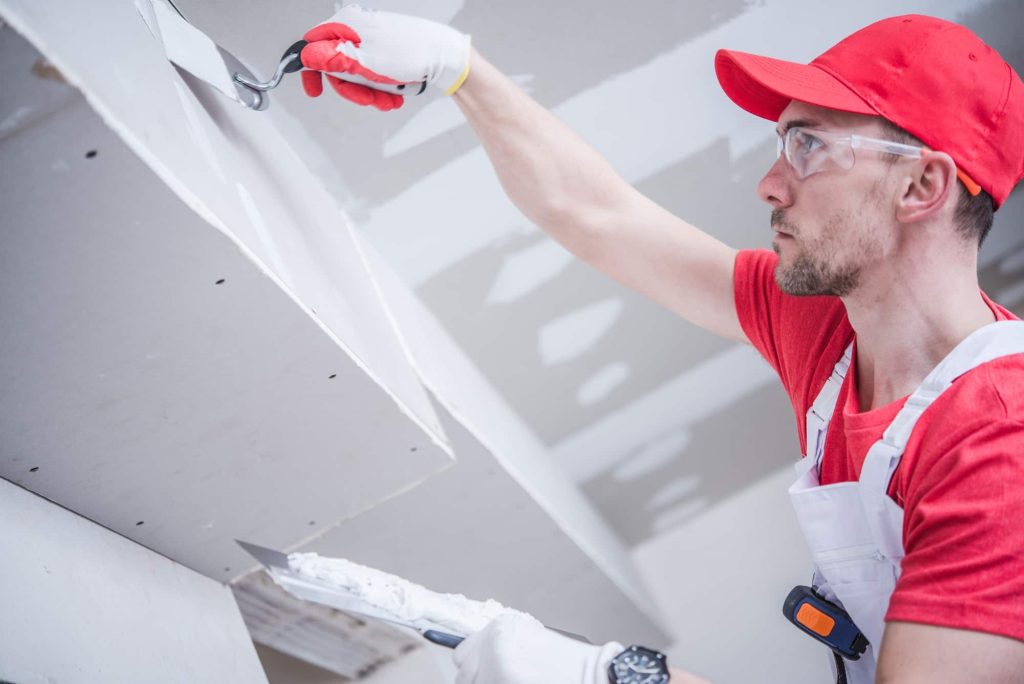Quality Drywall Installation That Changes Your Interiors
Quality Drywall Installation That Changes Your Interiors
Blog Article
Drywall Setup Made Easy: Tips for Perfect Outcomes
Drywall installation is usually regarded as an overwhelming job, yet with the appropriate method and knowledge, it can end up being a workable venture. Grasping methods for reducing, hanging, and completing drywall can considerably affect the result.
Selecting the Right Products
Picking the proper products for drywall installation is critical to accomplishing a long lasting and cosmetically pleasing finish. drywall contractor. The key element, drywall sheets, commonly come in various densities, with 1/2-inch sheets being typical for indoor walls. For locations needing added wetness resistance, such as cooking areas or restrooms, take into consideration using eco-friendly board or cement board, which are particularly made to stand up to humidity

Additionally, choosing the best bolts-- either nails or screws-- is vital for protecting the drywall to the framework. Drywall screws are usually preferred for their holding power and lowered threat of standing out. Lastly, take into consideration the complements such as primer and paint, which not only boost the appearance but also safeguard the drywall from moisture and wear.
Preparing the Installment Area
Before beginning the drywall installment process, it is essential to prepare the installment location extensively. A clean work space lessens the danger of damage to existing products and permits for effective activity during installment.
Following, examine the walls and ceiling for any flaws, such as fractures, holes, or mold. Address these concerns beforehand; spot any type of damages and enable enough time for repairs to completely dry. In addition, guarantee that electric outlets, switches, and pipes are correctly placed and represented, as this will certainly impact drywall placement.
Consider the environmental problems. A steady temperature and moisture level are important for optimum adhesion and performance of the drywall products. Use a dehumidifier or heater to develop appropriate conditions. if needed.
Cutting and Hanging Drywall
The trick to efficient drywall installation lies in the specific cutting and hanging of the panels. Make use of a straight side and an energy knife to rack up the drywall along your measurements, then snap it along the scored line for a clean break.

Constantly work from the top down and delegated right, ensuring that you preserve a staggered pattern to improve security. Correctly hanging the drywall sets the foundation for a smooth surface, ultimately leading to superior cause your drywall job.
Taping and Mudding Methods
While appropriate cutting and hanging of drywall establishes the stage, the next vital action involves understanding taping and mudding techniques to make sure a seamless finish. Taping is important for enhancing joints and avoiding cracks; it involves embedding tape right into the used joint compound (mud) Start with a high quality fiberglass or paper tape, applying the tape over the joint and pressing it right into the wet mud utilizing a taping knife, making certain no air bubbles remain.
When the tape remains in area, use a thin layer of joint substance over the tape, feathering the sides to create a smooth shift to the drywall surface. Permit this layer to completely dry completely prior to sanding it gently to remove blemishes. Repeat this procedure, using added coats of mud as necessary-- generally a couple of layers-- while slowly widening the application area with each layer to attain a seamless look.
After the last layer dries out, sand the surface with a fine-grit sandpaper until smooth. drywall fort worth. Bear in mind to wear a mask throughout sanding to stay clear pop over to this web-site of inhaling dust particles. Understanding these taping and mudding techniques is vital for attaining a professional-quality finish in your drywall setup
Completing Touches for Excellence
Accomplishing a flawless drywall installation surpasses mudding and taping; it finishes in the finishing touches that boost the general appearance. These final actions are essential in ensuring a professional-grade finish that boosts the visual appeals of your space.
Begin by sanding the dried joint substance to create a smooth surface area. drywall fort worth. After fining sand, clean down the wall surfaces with a wet fabric to eliminate any type of dirt fragments, guaranteeing a clean surface for painting.
Following, use a primer particularly made for drywall. This step is crucial, as it aids seal the joint compound and gives an uniform base for the topcoat. Once the guide dries out, check for any kind of blemishes, and touch up as needed.
Verdict
In final thought, successful drywall installation pivots on the mindful option of products, comprehensive preparation of the installment area, and specific implementation of reducing and hanging strategies. Mastery of taping and mudding procedures is important for attaining a smooth surface.
Drywall setup is usually perceived as a daunting job, yet with the ideal technique and knowledge, it can end up being a manageable venture.Choosing the ideal products for drywall installment is crucial to attaining a long lasting and aesthetically pleasing coating.Before starting the drywall installment procedure, it is important to prepare the installment location thoroughly. Understanding these taping and mudding strategies is essential for achieving a professional-quality surface in your drywall setup.
In conclusion, successful drywall installation hinges on the careful choice of materials, thorough preparation of the setup location, and see post exact implementation of cutting and hanging methods.
Report this page